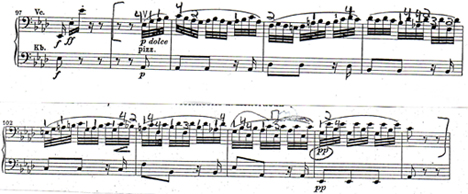
Exploring Beethoven’s Fifth: Second Variation
Jonathan Pegis
Picking up where we left off last time, at the conclusion of variation 1 it is a good idea to keep counting in between the two variations. You want to play this second variation in the exact tempo as the theme and first variation. I will say right at the outset that there is no ideal fingering for this excerpt! It just doesn’t lie well on the cello. My fingering is a bit unusual in that I do not use the thumb at all, or any open A strings. I do, however, use the A string for some of the notes. I highly recommend not playing the open A just because it tends to really stick out. Many cellists don’t use the A string at all which is also fine but usually necessitates using the thumb which I find a bit clumsy. The hardest part of my fingering is the blocked fifths with the fourth finger in measures 103 and 104. Some of my Northwestern students have used the third finger here while others have used the thumb on the low note and used 2 and 3 on the fifths. It’s probably best to experiment and see which fingering works best for you. If you use the blocked 4th finger it really helps if the fifths on your cello are true!
Here are a few comments on bowing this excerpt. I like to start up bow but this puts me at the frog on a down bow for the subito pp at measure 105. To solve this problem I sneak in a down bow halfway through measure 104. This gets me to the upper half for the pp, but not all the way to the tip. I also find it a good idea to not taper off dynamically in measure 104, because if you do then you have no room left for the subito pp. I have had a number of students simply reverse the bowing and begin this passage down bow, and I have been occasionally tempted to do this. However, there is something about the string crossings in measure 101 that I find awkward on an up bow. Again, it’s a good idea to experiment, and don’t forget to record yourself!
I should comment on the numerous string crossings which are difficult to make smooth with the right hand. It helps if you “minimize” the string crossings so you just barely avoid playing chords. On the A and D crossings I usually recommend that the plane of the bow is low on the A string and high on the D. Be firm enough in the wrist—but not rigid–so that the crossings are very even. Slow and steady breathing helps a lot too.
What are some of the musical considerations in this excerpt? Well, like variation 1 we want to use the same singing piano sound which is focused but not loud. Phrase the way we did the theme, with a slight crescendo in measure 101. It also makes a big difference if you can apply a gentle vibrato throughout much of the excerpt. I admit this is pretty hard to do on those pesky fifths, regardless of fingering! And like the first variation, avoid using portato to hide the shifts. This excerpt should be seamless and hopefully sound effortless to the committee.
We have come to the end of our discussion of Beethoven’s Fifth. I welcome comments, feedback, and suggestions for future excerpts to explore.
Subjects: Orchestra, Repertoire
Tags: audition excerpt, Auditions, Beethoven, Beethoven Symphonies, Beethoven's 5th Symphony, bow control, bowings, breathing, cello, cello excerpt, cellobello, control, effortless, experiment, experimentation, fingerings, intonation, Jonathan, Northwestern, pacing, Pegis, phrasing, slow breathing, string crossings, Symphony, tempo, variations, variations on a theme, vibrato

